Online System for Kangaroo Taxi: Design and UML Diagrams Report
VerifiedAdded on 2022/09/26
|15
|2570
|20
Project
AI Summary
This project report details the design of an online system for Kangaroo Taxi, an Australian company aiming to implement a new taxi booking website. The report utilizes Unified Modeling Language (UML) diagrams to provide a comprehensive overview of the system's architecture and functionality. It begins with an introduction outlining the project's objectives and context. The core of the report includes a use case diagram and descriptions, which illustrate the system's behavior and how actors interact with it, particularly focusing on customer registration and booking processes. An Entity-Relationship (ER) diagram is presented to model the database design, ensuring efficient data storage and retrieval. Furthermore, the report incorporates a class diagram to define the system's classes, their attributes, and relationships, followed by sequence and activity diagrams to depict the dynamic interactions and control flow within the system, respectively. The report concludes by summarizing the key findings and emphasizing the importance of UML diagrams in system analysis and design, offering a clear understanding of the online system's internal workings. The diagrams include customer, car, driver, payment, and booking entities with their attributes and relationships.
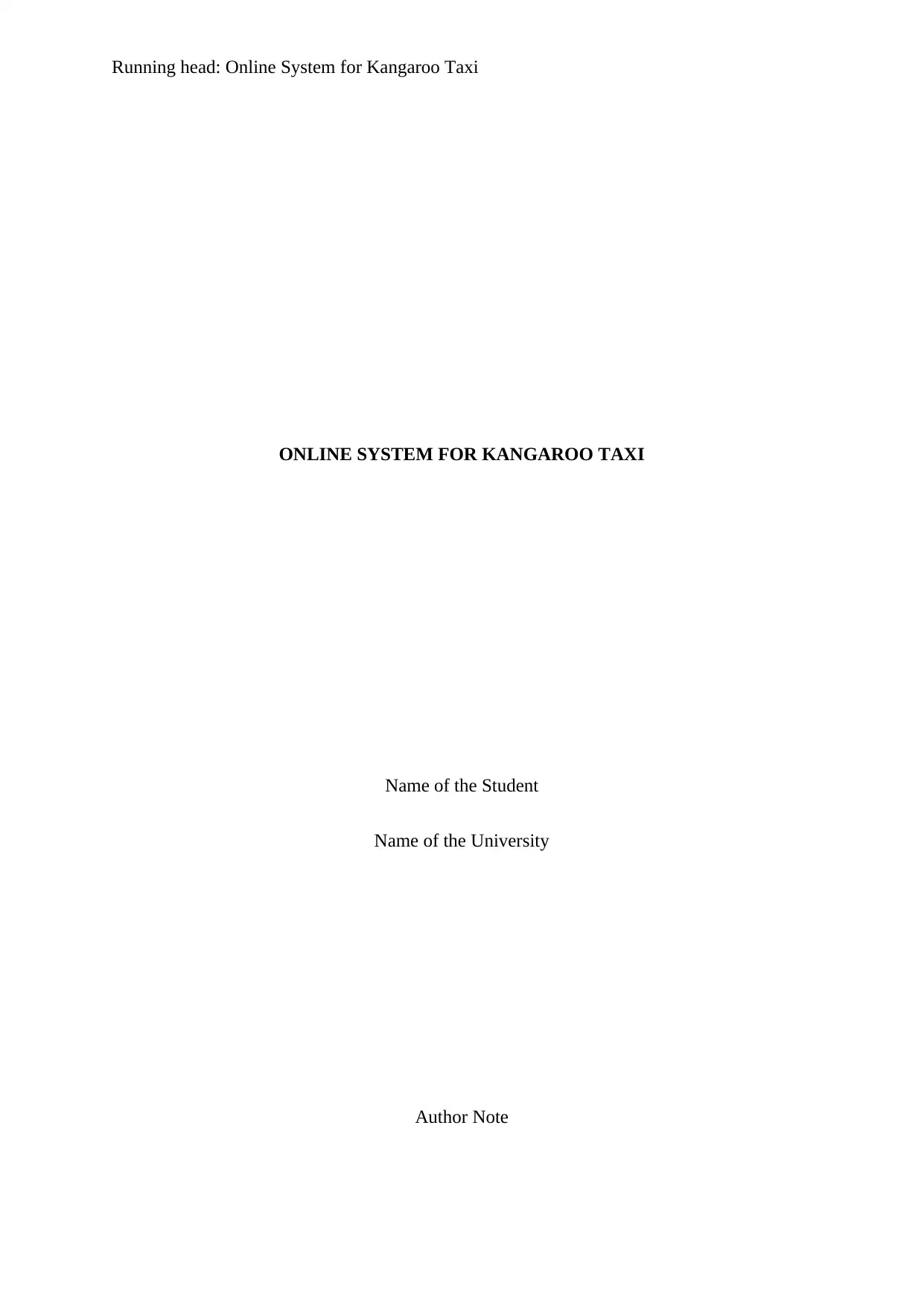
Running head: Online System for Kangaroo Taxi
ONLINE SYSTEM FOR KANGAROO TAXI
Name of the Student
Name of the University
Author Note
ONLINE SYSTEM FOR KANGAROO TAXI
Name of the Student
Name of the University
Author Note
Paraphrase This Document
Need a fresh take? Get an instant paraphrase of this document with our AI Paraphraser
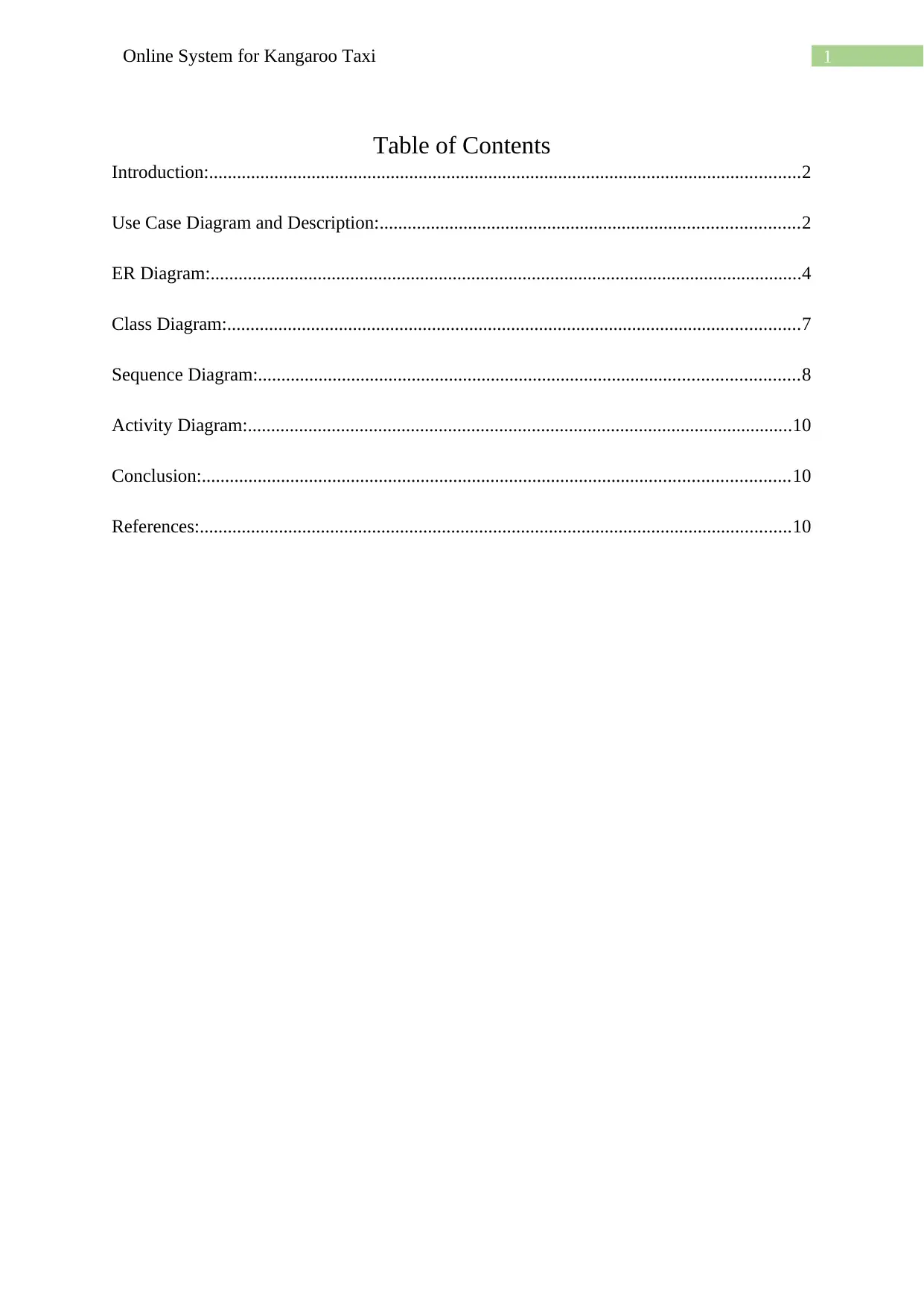
1Online System for Kangaroo Taxi
Table of Contents
Introduction:...............................................................................................................................2
Use Case Diagram and Description:..........................................................................................2
ER Diagram:...............................................................................................................................4
Class Diagram:...........................................................................................................................7
Sequence Diagram:....................................................................................................................8
Activity Diagram:.....................................................................................................................10
Conclusion:..............................................................................................................................10
References:...............................................................................................................................10
Table of Contents
Introduction:...............................................................................................................................2
Use Case Diagram and Description:..........................................................................................2
ER Diagram:...............................................................................................................................4
Class Diagram:...........................................................................................................................7
Sequence Diagram:....................................................................................................................8
Activity Diagram:.....................................................................................................................10
Conclusion:..............................................................................................................................10
References:...............................................................................................................................10

2Online System for Kangaroo Taxi
Introduction:
An Australian company Kangaroo Taxi wants to implement a new online taxi booking
website. Any person can use their website to book a taxi. Users can use their smartphone to
access this website. This report can provide a basic overview of the online system for
kangaroo by using UML diagrams. Use case and use case description is discussed in this
project. Use case diagram can provide a basic overview of the system. ER diagram also
present in this paper. With the help of ER diagram, a database can be implemented and it will
reduce error during database implementation. class diagram provides every essentials classes
within the system and their function. Sequence diagram provides the interaction between
actor and objects in this project. And from registration to taxi bookings every step provided in
the activity diagram. After reading this report any person can get a clear idea about how this
system works internally.
Use Case Diagram and Description:
This diagram can display the primary form of system requirements. This diagram can
provide the proper behaviour of a system and how actors interact with the system (Torre et
al. 2018). this diagram can also summarize the relationship between actors, use case and
system. The use case diagram for this system is given below:
Introduction:
An Australian company Kangaroo Taxi wants to implement a new online taxi booking
website. Any person can use their website to book a taxi. Users can use their smartphone to
access this website. This report can provide a basic overview of the online system for
kangaroo by using UML diagrams. Use case and use case description is discussed in this
project. Use case diagram can provide a basic overview of the system. ER diagram also
present in this paper. With the help of ER diagram, a database can be implemented and it will
reduce error during database implementation. class diagram provides every essentials classes
within the system and their function. Sequence diagram provides the interaction between
actor and objects in this project. And from registration to taxi bookings every step provided in
the activity diagram. After reading this report any person can get a clear idea about how this
system works internally.
Use Case Diagram and Description:
This diagram can display the primary form of system requirements. This diagram can
provide the proper behaviour of a system and how actors interact with the system (Torre et
al. 2018). this diagram can also summarize the relationship between actors, use case and
system. The use case diagram for this system is given below:
⊘ This is a preview!⊘
Do you want full access?
Subscribe today to unlock all pages.

Trusted by 1+ million students worldwide

3Online System for Kangaroo Taxi
Figure 1: Use case diagram of an online system for kangaroo Taxi
(Source: Created by Author)
Use case description as:
Name Add a New customer Registration
ID UC1
Description To book a taxi, a customer needs to register at the website. After the
registration, the system can record every essential information about a
customer. The system generates temporary the id and password for a
customer. After successful registration, a customer can book a taxi.
Actors User
Figure 1: Use case diagram of an online system for kangaroo Taxi
(Source: Created by Author)
Use case description as:
Name Add a New customer Registration
ID UC1
Description To book a taxi, a customer needs to register at the website. After the
registration, the system can record every essential information about a
customer. The system generates temporary the id and password for a
customer. After successful registration, a customer can book a taxi.
Actors User
Paraphrase This Document
Need a fresh take? Get an instant paraphrase of this document with our AI Paraphraser

4Online System for Kangaroo Taxi
Organizational
Benefits
The organization can have every information of a customer.
Frequency of Use Whenever a new customer tries to book a taxi by using this system.
Triggers When a customer wants to book a taxi.
Preconditions Every customer need registration to book a taxi.
Post-conditions Customer can find and book a taxi.
Main Course 1. Customer opens the browser form their phone.
2. Customer provide every detail for registration.
3. Customer can click on registration.
Exceptions None.
Use case description as:
Name Booking
ID UC2
Description After registration, a customer can search for a taxi within their
locality. Customer can book a taxi by using their smartphone.
Actors User
Organizational
Benefits
Organization can easily handle every customer and gain a customer
base. Nowadays every customer wants a system that is fast secure and
user friendly.
Frequency of Use Whenever a customer wants to travel.
Triggers When a customer needs a transport vehicle.
Preconditions Customer needs a vehicle for transport.
Organizational
Benefits
The organization can have every information of a customer.
Frequency of Use Whenever a new customer tries to book a taxi by using this system.
Triggers When a customer wants to book a taxi.
Preconditions Every customer need registration to book a taxi.
Post-conditions Customer can find and book a taxi.
Main Course 1. Customer opens the browser form their phone.
2. Customer provide every detail for registration.
3. Customer can click on registration.
Exceptions None.
Use case description as:
Name Booking
ID UC2
Description After registration, a customer can search for a taxi within their
locality. Customer can book a taxi by using their smartphone.
Actors User
Organizational
Benefits
Organization can easily handle every customer and gain a customer
base. Nowadays every customer wants a system that is fast secure and
user friendly.
Frequency of Use Whenever a customer wants to travel.
Triggers When a customer needs a transport vehicle.
Preconditions Customer needs a vehicle for transport.
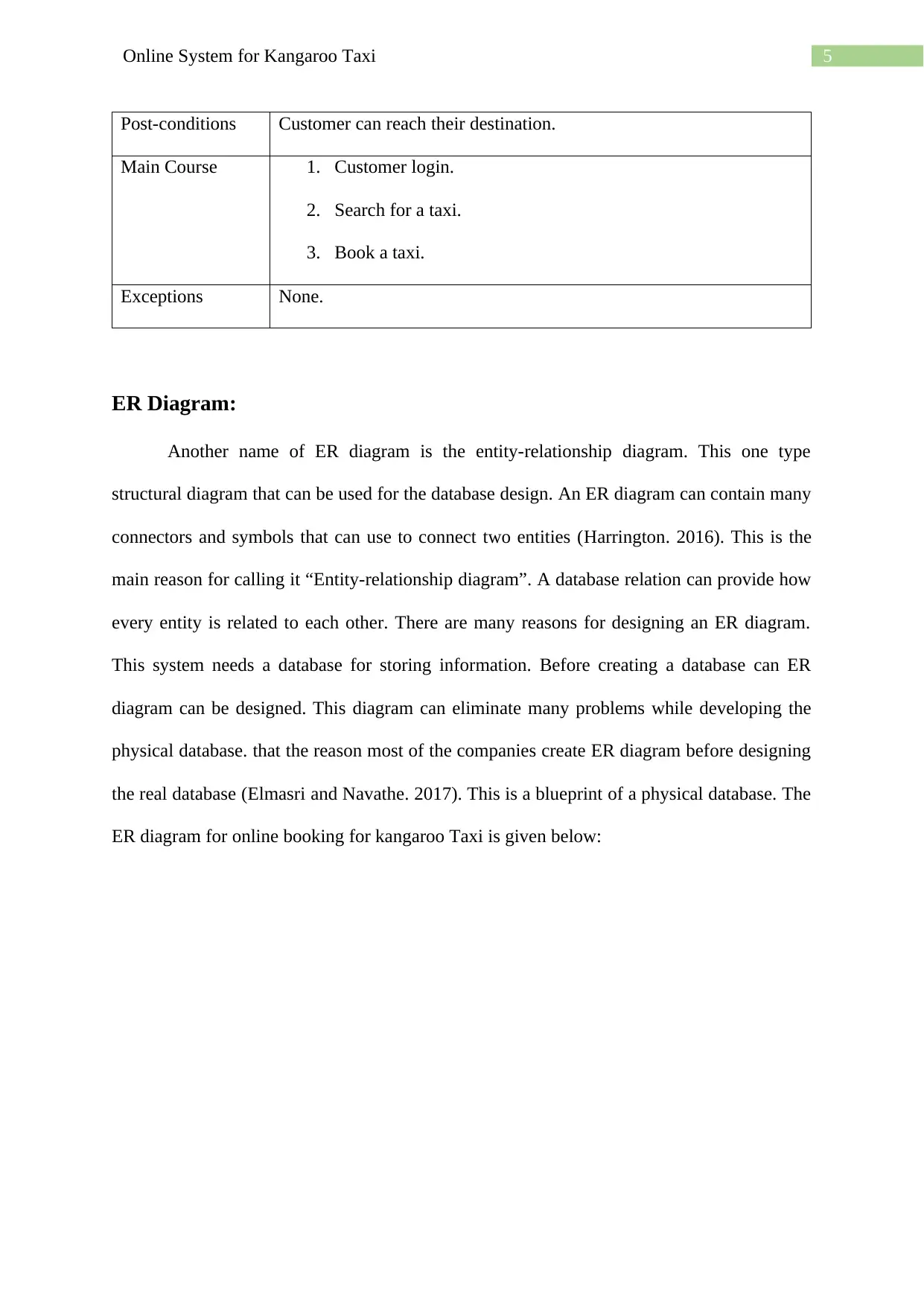
5Online System for Kangaroo Taxi
Post-conditions Customer can reach their destination.
Main Course 1. Customer login.
2. Search for a taxi.
3. Book a taxi.
Exceptions None.
ER Diagram:
Another name of ER diagram is the entity-relationship diagram. This one type
structural diagram that can be used for the database design. An ER diagram can contain many
connectors and symbols that can use to connect two entities (Harrington. 2016). This is the
main reason for calling it “Entity-relationship diagram”. A database relation can provide how
every entity is related to each other. There are many reasons for designing an ER diagram.
This system needs a database for storing information. Before creating a database can ER
diagram can be designed. This diagram can eliminate many problems while developing the
physical database. that the reason most of the companies create ER diagram before designing
the real database (Elmasri and Navathe. 2017). This is a blueprint of a physical database. The
ER diagram for online booking for kangaroo Taxi is given below:
Post-conditions Customer can reach their destination.
Main Course 1. Customer login.
2. Search for a taxi.
3. Book a taxi.
Exceptions None.
ER Diagram:
Another name of ER diagram is the entity-relationship diagram. This one type
structural diagram that can be used for the database design. An ER diagram can contain many
connectors and symbols that can use to connect two entities (Harrington. 2016). This is the
main reason for calling it “Entity-relationship diagram”. A database relation can provide how
every entity is related to each other. There are many reasons for designing an ER diagram.
This system needs a database for storing information. Before creating a database can ER
diagram can be designed. This diagram can eliminate many problems while developing the
physical database. that the reason most of the companies create ER diagram before designing
the real database (Elmasri and Navathe. 2017). This is a blueprint of a physical database. The
ER diagram for online booking for kangaroo Taxi is given below:
⊘ This is a preview!⊘
Do you want full access?
Subscribe today to unlock all pages.

Trusted by 1+ million students worldwide
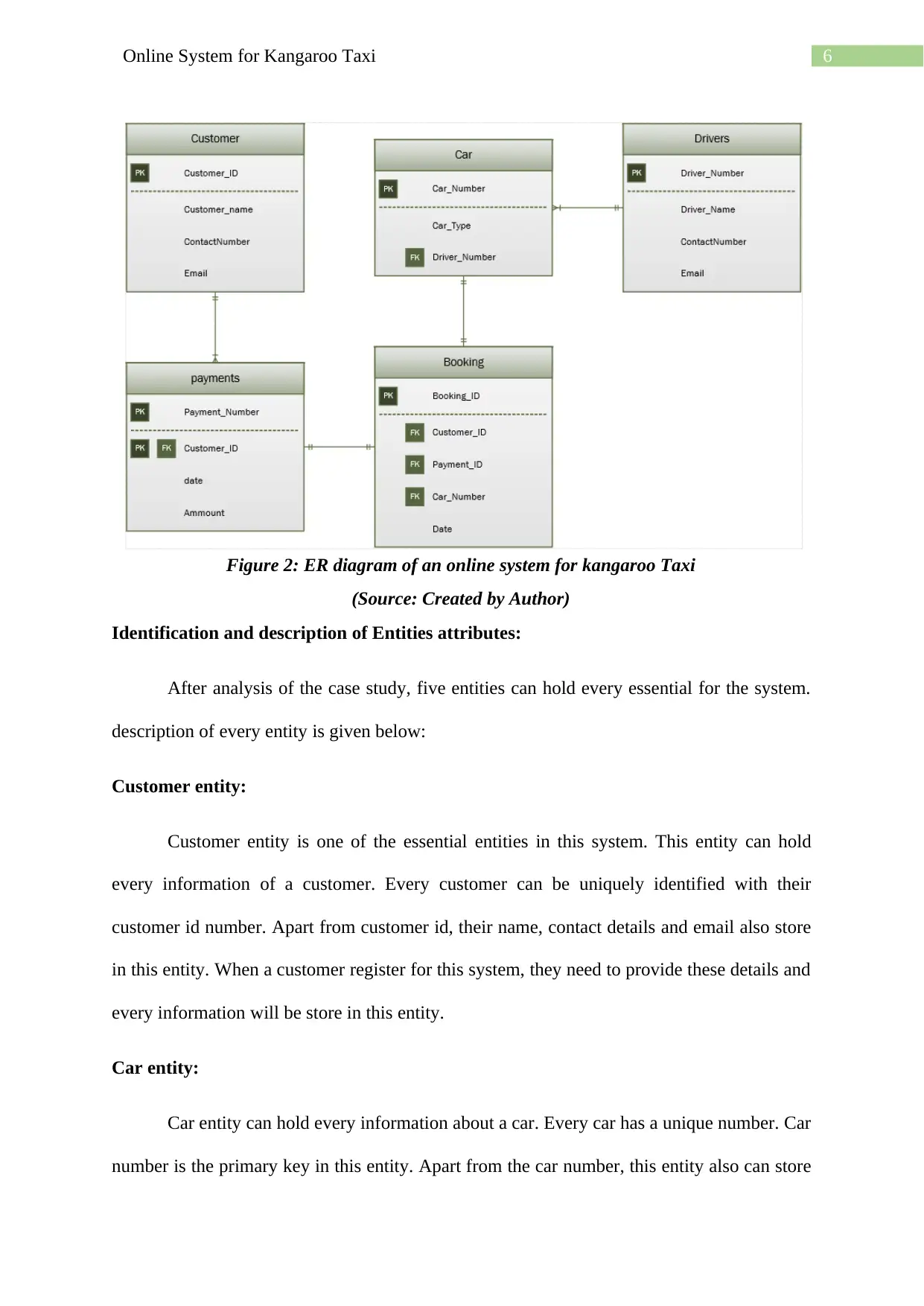
6Online System for Kangaroo Taxi
Figure 2: ER diagram of an online system for kangaroo Taxi
(Source: Created by Author)
Identification and description of Entities attributes:
After analysis of the case study, five entities can hold every essential for the system.
description of every entity is given below:
Customer entity:
Customer entity is one of the essential entities in this system. This entity can hold
every information of a customer. Every customer can be uniquely identified with their
customer id number. Apart from customer id, their name, contact details and email also store
in this entity. When a customer register for this system, they need to provide these details and
every information will be store in this entity.
Car entity:
Car entity can hold every information about a car. Every car has a unique number. Car
number is the primary key in this entity. Apart from the car number, this entity also can store
Figure 2: ER diagram of an online system for kangaroo Taxi
(Source: Created by Author)
Identification and description of Entities attributes:
After analysis of the case study, five entities can hold every essential for the system.
description of every entity is given below:
Customer entity:
Customer entity is one of the essential entities in this system. This entity can hold
every information of a customer. Every customer can be uniquely identified with their
customer id number. Apart from customer id, their name, contact details and email also store
in this entity. When a customer register for this system, they need to provide these details and
every information will be store in this entity.
Car entity:
Car entity can hold every information about a car. Every car has a unique number. Car
number is the primary key in this entity. Apart from the car number, this entity also can store
Paraphrase This Document
Need a fresh take? Get an instant paraphrase of this document with our AI Paraphraser

7Online System for Kangaroo Taxi
information of car type and driver number. Many types of car are used for the business. and
driver information is also stored in the database. with the help of the driver number, car
authority can easily identify which driver drives a car. Driver number is the foreign key in
this entity.
Driver entity:
This is a taxi booking system and every car can be driven only registered driver.
Every driver information will be store in this entity. Information of a driver is essential for
the company because every driver carries big responsibility for the organization. Every driver
can be identifying with their unique driver number. Apart from the number this entity can
store driver full name, their contact number and their email.
Payment entity:
Every customer needs to pay for every ride, so the payment entity is one of the main
entities in this system. this entity can store every payment-related information such as
payment number, payment date and amount. It also can store a registered customer number so
that authority can identify if a customer completes their payment or not. Payment id is the
unique number in this entity.
Booking entity:
Booking is one of the important entities in this system because every booking related
information will be store in this entity. Every booking number is different, authority can
easily find information about booking with the help of a booking number. Apart from the
booking number, this entity can store customer number, unique number of payments, car
number and booking date. This information is essential information for each booking.
customer number, payment number, car number is the foreign key in this entity.
information of car type and driver number. Many types of car are used for the business. and
driver information is also stored in the database. with the help of the driver number, car
authority can easily identify which driver drives a car. Driver number is the foreign key in
this entity.
Driver entity:
This is a taxi booking system and every car can be driven only registered driver.
Every driver information will be store in this entity. Information of a driver is essential for
the company because every driver carries big responsibility for the organization. Every driver
can be identifying with their unique driver number. Apart from the number this entity can
store driver full name, their contact number and their email.
Payment entity:
Every customer needs to pay for every ride, so the payment entity is one of the main
entities in this system. this entity can store every payment-related information such as
payment number, payment date and amount. It also can store a registered customer number so
that authority can identify if a customer completes their payment or not. Payment id is the
unique number in this entity.
Booking entity:
Booking is one of the important entities in this system because every booking related
information will be store in this entity. Every booking number is different, authority can
easily find information about booking with the help of a booking number. Apart from the
booking number, this entity can store customer number, unique number of payments, car
number and booking date. This information is essential information for each booking.
customer number, payment number, car number is the foreign key in this entity.

8Online System for Kangaroo Taxi
Class Diagram:
A Class diagram is one type of UML diagram that can provide every class within a
system. This is a static structure diagram that can describe the entire structure of a system by
providing its classes, attributes, data types, methods and relationship between objects (Torre
et al. 2018). This diagram can be designed for software developers to develop this system.
This diagram can provide the state of a class and one class can be involved with many
classes.
Figure 3: Class Diagram of an online system for kangaroo Taxi
(Source: Created by Author)
Form the analysis from figure 3 class diagram, it can be said that seven class can
maintain most of the function in this system. New Customer and registered customer both are
the users of this system. By providing name, password and address, a new customer can
register themselves in the system. after the registration, they can log in. User class contains
user name and password and performs features like registration and login. This class can help
Class Diagram:
A Class diagram is one type of UML diagram that can provide every class within a
system. This is a static structure diagram that can describe the entire structure of a system by
providing its classes, attributes, data types, methods and relationship between objects (Torre
et al. 2018). This diagram can be designed for software developers to develop this system.
This diagram can provide the state of a class and one class can be involved with many
classes.
Figure 3: Class Diagram of an online system for kangaroo Taxi
(Source: Created by Author)
Form the analysis from figure 3 class diagram, it can be said that seven class can
maintain most of the function in this system. New Customer and registered customer both are
the users of this system. By providing name, password and address, a new customer can
register themselves in the system. after the registration, they can log in. User class contains
user name and password and performs features like registration and login. This class can help
⊘ This is a preview!⊘
Do you want full access?
Subscribe today to unlock all pages.

Trusted by 1+ million students worldwide

9Online System for Kangaroo Taxi
a customer for registration and login. with the help of this class, a new customer and an
existing customer registered and log into the system. User class is the parent class of new
customer and registered customer class. Registered customer class is working for an existing
customer. This class also store customer name password and address. This class can perform
edit profile operation. Payment is one of the important class in this system. this class can
store payment id and amount. This class can perform a pay function. Booking class also
perform several operations within the system. this class can perform store information of
booking id, pick up location, drop location, driver details. A customer can update and show
information with the help of this class. Manage booking class is helpful for this system. it can
perform edit profile and cancel booking operation. With the help of search taxi class, a user
can easily search taxi in their area. Cab id, type and cab current address can be store in this
class and it can perform a function like, choose taxi and display taxi information.
Sequence Diagram:
This diagram also known as the interaction diagram because it can represent the
interaction between actors and different systems. This diagram provides how every operation
can be carried out. It can capture every interaction between every object (Torre et al. 2018).
This diagram shows the interaction in proper order. With the help of this diagram, any person
can get an idea about how this system works internally. Class diagram provides a static
overview of the system while a sequence diagram can provide a dynamic overview of a
system.
a customer for registration and login. with the help of this class, a new customer and an
existing customer registered and log into the system. User class is the parent class of new
customer and registered customer class. Registered customer class is working for an existing
customer. This class also store customer name password and address. This class can perform
edit profile operation. Payment is one of the important class in this system. this class can
store payment id and amount. This class can perform a pay function. Booking class also
perform several operations within the system. this class can perform store information of
booking id, pick up location, drop location, driver details. A customer can update and show
information with the help of this class. Manage booking class is helpful for this system. it can
perform edit profile and cancel booking operation. With the help of search taxi class, a user
can easily search taxi in their area. Cab id, type and cab current address can be store in this
class and it can perform a function like, choose taxi and display taxi information.
Sequence Diagram:
This diagram also known as the interaction diagram because it can represent the
interaction between actors and different systems. This diagram provides how every operation
can be carried out. It can capture every interaction between every object (Torre et al. 2018).
This diagram shows the interaction in proper order. With the help of this diagram, any person
can get an idea about how this system works internally. Class diagram provides a static
overview of the system while a sequence diagram can provide a dynamic overview of a
system.
Paraphrase This Document
Need a fresh take? Get an instant paraphrase of this document with our AI Paraphraser
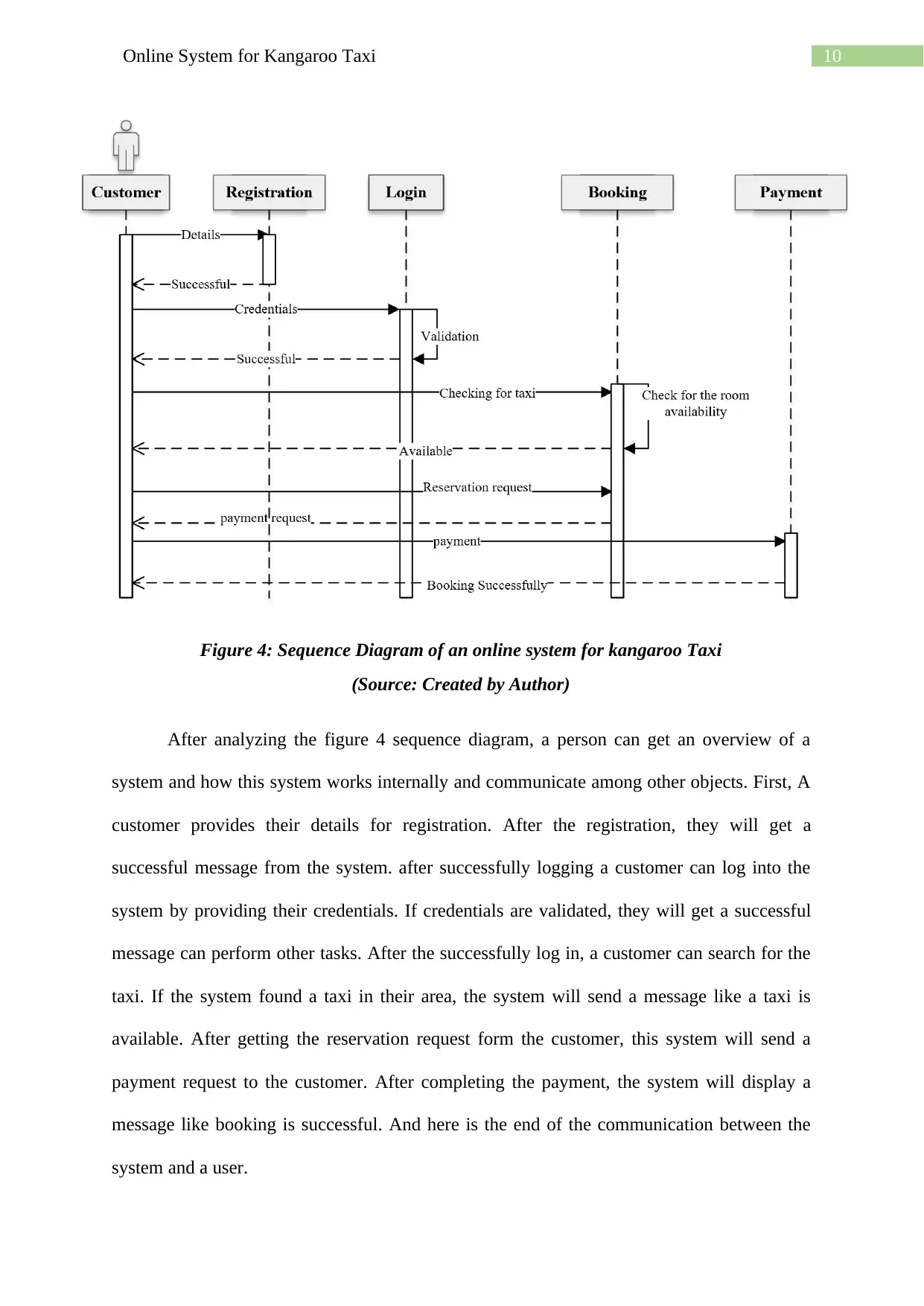
10Online System for Kangaroo Taxi
Figure 4: Sequence Diagram of an online system for kangaroo Taxi
(Source: Created by Author)
After analyzing the figure 4 sequence diagram, a person can get an overview of a
system and how this system works internally and communicate among other objects. First, A
customer provides their details for registration. After the registration, they will get a
successful message from the system. after successfully logging a customer can log into the
system by providing their credentials. If credentials are validated, they will get a successful
message can perform other tasks. After the successfully log in, a customer can search for the
taxi. If the system found a taxi in their area, the system will send a message like a taxi is
available. After getting the reservation request form the customer, this system will send a
payment request to the customer. After completing the payment, the system will display a
message like booking is successful. And here is the end of the communication between the
system and a user.
Figure 4: Sequence Diagram of an online system for kangaroo Taxi
(Source: Created by Author)
After analyzing the figure 4 sequence diagram, a person can get an overview of a
system and how this system works internally and communicate among other objects. First, A
customer provides their details for registration. After the registration, they will get a
successful message from the system. after successfully logging a customer can log into the
system by providing their credentials. If credentials are validated, they will get a successful
message can perform other tasks. After the successfully log in, a customer can search for the
taxi. If the system found a taxi in their area, the system will send a message like a taxi is
available. After getting the reservation request form the customer, this system will send a
payment request to the customer. After completing the payment, the system will display a
message like booking is successful. And here is the end of the communication between the
system and a user.
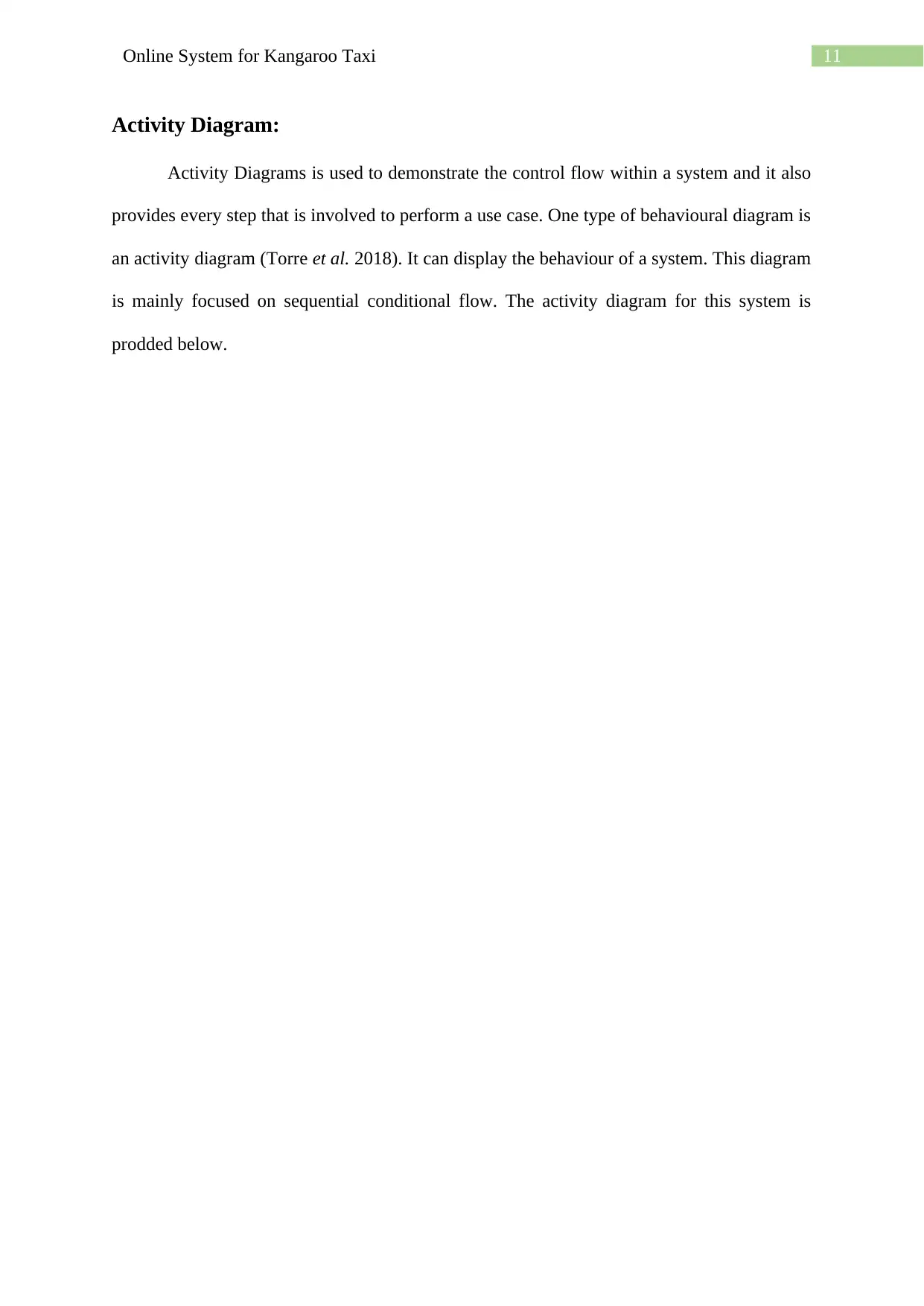
11Online System for Kangaroo Taxi
Activity Diagram:
Activity Diagrams is used to demonstrate the control flow within a system and it also
provides every step that is involved to perform a use case. One type of behavioural diagram is
an activity diagram (Torre et al. 2018). It can display the behaviour of a system. This diagram
is mainly focused on sequential conditional flow. The activity diagram for this system is
prodded below.
Activity Diagram:
Activity Diagrams is used to demonstrate the control flow within a system and it also
provides every step that is involved to perform a use case. One type of behavioural diagram is
an activity diagram (Torre et al. 2018). It can display the behaviour of a system. This diagram
is mainly focused on sequential conditional flow. The activity diagram for this system is
prodded below.
⊘ This is a preview!⊘
Do you want full access?
Subscribe today to unlock all pages.

Trusted by 1+ million students worldwide
1 out of 15
Related Documents
Your All-in-One AI-Powered Toolkit for Academic Success.
+13062052269
info@desklib.com
Available 24*7 on WhatsApp / Email
![[object Object]](/_next/static/media/star-bottom.7253800d.svg)
Unlock your academic potential
Copyright © 2020–2025 A2Z Services. All Rights Reserved. Developed and managed by ZUCOL.




